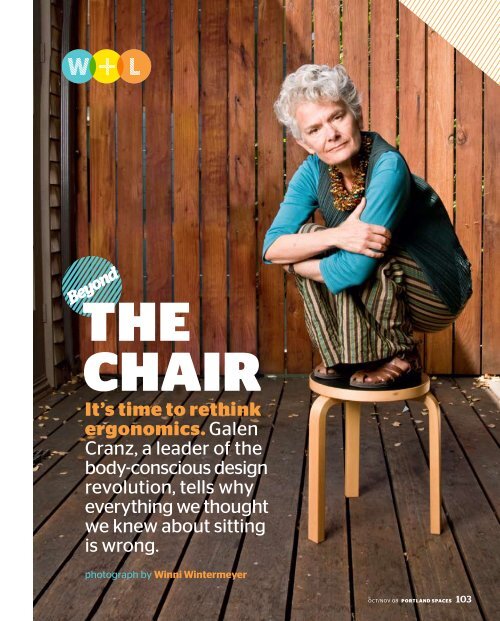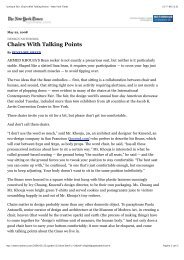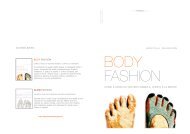You also want an ePaper? Increase the reach of your titles
YUMPU automatically turns print PDFs into web optimized ePapers that Google loves.
BeyondTHECHAIRIt’s time to rethinkergonomics. GalenCranz, a leader of thebody-conscious designrevolution, tells whyeverything we thoughtwe knew about sittingis wrong.photograph by Winni WintermeyerOCT/NOV 08 P O RT L A N D S PAC E S 103
Better <strong>Body</strong> TipsAt WorkA ConversationWith Galen Cranzby Melissa DaltonGALEN CRANZ HAS MADE a career out of telling people to stop sitting still.A professor of social architecture at the University of California, Berkeley, andauthor of <strong>The</strong> <strong>Chair</strong>: Rethinking Culture, <strong>Body</strong>, and <strong>Design</strong> (W.W. Norton &Company, 1998), Cranz argues that the Western tradition of right-angled chairsis harmful to our health. <strong>The</strong> posture it forces is the C-slumped spine: <strong>The</strong> chestcaves in, the pelvis gets crunched, the lower back collapses, and the neck thrustsour heads forward. As a result, we live with myriad aches and pains, exacerbatedby the growing number of hours most of us spend in front of a computer every day.Small wonder why lower back pain is second only to the common cold in causingAmericans’ sick days. Decades of ergonomics research have helped us to betteradapt our work environments to our bodies and tasks, which has, in turn, reducedour pain to some degree. But Cranz believes that these “ergonomic principles justdon’t go far enough.”Her solution? A concept called “body-conscious design”—a comprehensiveapproach to creating living and working environments that better support ourbodies and their propensity for movement. Recently, Cranz spoke with PortlandSpaces about body-conscious design and how it could (and should) be incorporatedinto the workplace. When asked if designers and office-furniture companiesare close to realizing this vision, Cranz chuckled, “<strong>The</strong>y haven’t caught upwith me yet.”A 2001 study of deskboundoffice workersfound that the averageperson made 53 changesto his or her torsoposition in an hour. Humansneed to move innatural, healthy ways—but they also need toget their work done.<strong>The</strong>se things don’thave to be mutuallyexclusive. Make thesebody-conscious adjustmentswherever youwork to rechannel yourfidgeting into fitness.illustrations byArthur MountPORTLAND SPACES: You’re a proponent of bodyconsciousdesign. How does that differ from ergonomics?GALEN CRANZ: Ergonomics is concerned with mechanics and parts of thebody. I’m more concerned with total systems, the role of culture and psychology,and making cultural change. We’re not just dealing with a mechanical problemabout how we’re going to be more comfortable. It’s a cultural problem.What’s our problem?Consumers are not happy. <strong>The</strong>y complain about the chairs. Consumers don’tknow why they’re so unhappy with the chair. When pressed, all they can say is,“Well, we know we’re supposed to sit up straight.” We are confused about our ownexperience. We’re not happy, but we don’t have the vocabulary and the analysisto understand why we’re unhappy. And that’s what I’ve tried to provide—theanalysis to explain why the chair doesn’t work—so that we have some languageto begin to express our unhappiness, our pains, our sorrows at sitting, and toprovide a more articulate consumer base so that designers and manufacturerscan move forward.CHAIR GUIDEVariable Balans(top) designed byPeter Opsvik, manufacturedby Variér (www.varierfurniture.com);$495 from www.backcarebasics.comBalanceBall(bottom left) byGaiam (www.gaiam.com); $30 at WholeFoods Market,multiple locations104 P O RT L A N D S PAC E S OCT/NOV 08
CustomizeYour SpaceWorkplace pain is caused by therepetition of awkward posturesin an environment that is notproperly tailored to your body. Somake it your own. Wrists, elbows,neck, and knees should feel as ifthey were sighing with relief.GET A HEADSETBalancing the phone betweenyour ear and shoulder cancreate neck pain that radiatesall the way down your arm.A hands-free device will helpkeep your neck aligned.REPOSITION YOUR MOUSEWhen positioned on the rightside of a keyboard, the mousetilts the wrist at an unnaturalangle and can exacerbaterepetitive strain injuries liketennis elbow. Try Evoluent’svertical mouse, which promotesa neutral wrist andforearm posture.ADJUST YOUR COMPUTERTo prevent eyestrain, positionthe center of the screen 7 to 10inches below your horizontalsight line and a little less thanan arm’s length away. Lookaway from the screen every 30minutes and focus on an objectabout 20 feet away.FIT YOUR CHAIR TO YOURBODY—AND TO YOUR TASKProlonged sitting is hard onthe body. Change the seat’stilt so that your knees are lowerthan your hips, at about a100-degree angle. This willmaintain the natural lumbarcurve in your back.MakeLike GumbyChanging up your seat periodically,like switching to a kneeling chair ora yoga ball, encourages a greaterrange in movement and allows youto work different muscle groups.SIT ON A BALLDrape yourself over ayoga ball to stretch outyour spine. (Just avoidslumping and roundingyour spine if you’re usingit as your primary chair.)Stretch YourHorizonsSince there are health risks associatedwith sitting in a static positionfor too long, take a 1- to 3-minutebreak every hour to move around.MAKE TIME TO STRETCHWhen you feel your musclestiring, take a few minutes tostretch them (some helpfuldesk exercises can be foundat www.yoga.about.com).TAKE FREQUENTSTROLLSGo talk to your coworkersin personinstead of e-mailingor calling them.OCT/NOV 08 P O RT L A N D S PAC E S 105
Your landmark 1998 book called for a revolution in chairdesign. What kind of reactions did you get?<strong>The</strong>re were protests—first to changing the height of tables and desks. Perching,or sitting with your legs at a 120-degree angle, is better for you anatomically, andto do so you need a higher work surface. So that means you change not only thechair, but also the work surface. You can’t change one piece without changinganother. Today, a lot of office people have adjustable work surfaces. But years ago,when I was calling for a better system, people said, “That will never happen.Nobody can afford adjustability.” But because of repetitive strain injury, suddenlymoney is no object! A new chair is much cheaper than a medical problem.What postures do you think we haveunconscious cultural assumptions about?Squatting, for example, we think of as very primitive. But children squat very well,and in cultures where people still squat, women don’t have problems in labor. Sosquatting is really healthy. People around the world eat, work, and wait squatting,but the West views that as a sign of poverty and being “less developed.” An anthropologistnamed Gordon Hughes studied postures around the world, and he arguedthat the West really needed to look at the work postures of other cultures andintegrate them into our life. Kneeling, squatting, sitting cross-legged, lounging—these are all perfectly useful positions.Why do we need all these postures during the day?It’s not that it’s bad to sit; it’s just that it’s bad to sit for very long. <strong>The</strong>re is noperfect single position. As a species we’re designed for movement and change.What office tasks can you do in a lounge position?You can do your computing that way. Bring your keyboard on your lap and yourmonitor on a swinging arm. <strong>The</strong> lounge position is really good because your headis up. You can have eye contact with the screen or other people. Your feet areelevated too, so that you don’t get any unnatural curve in your spine. You distributegravity in a very different way than you do when you’re seated. But the problemis it looks like you’re lying down on the job.What’s your best argument to the senior partners ata law firm that their junior associates should get to reclineor lie down on the job?Well, there’s a lot of research about how cognitive function is improved with movementand diminishes without it. If you want an alert, intellectual work force, you’vegot to build in movement and that means you need more than one posture. You haveto make it OK to cycle through [different postures] six times an hour. That includesthe resting position. It’s very restorative for your spine and the spinal cord.What does the body-consciousworkstation of the future look like?I can see an environment that has platforms that you could sit cross-legged on,that you could squat on, and that you could lie down on. Within the course of aday you would have a whole choreography of work postures—there would be sixpositions an hour that you would rotate through over the eight hours that youwork. Can you imagine that?I’m trying to picture it…I’m lying on one right now. I had them custom designed for my office. <strong>The</strong>re’s a lotyou can do with these platforms, whether they’re fixed or mobile. And you can havea floor-based office. <strong>The</strong>re’s so much you could do, if you just rethink all the surfaces.Better <strong>Body</strong> TipsAt HomeGalen Cranz envisions afuture workstation thatsupports a “choreography”of body posturesover the course of eachday, including reclining,sitting, squatting, kneeling,and standing. Butbody-conscious designisn’t just for our workenvironments. As Cranzwrites, “Changing yourposture means changingyour lifestyle.” Takeanother look at yourspace. Where can youincorporate a choreographyof different posturesinto your life?CHAIR GUIDE<strong>The</strong> Zafu(bottom left) by Organic Dream Pillows(www.organicdreampillows.com); $50(blue, tan, purple/green) at MiradorCommunity Store, 2106 SE Division St,503-231-5175, www.miradorcommunitystore.com106 P O RT L A N D S PAC E S OCT/NOV 08
Rethink YourSurfacesFrom high to low, the surfacesin your home affect the way youmove. Once you know how yourhome environment impacts yourbody, there are small changes youcan make to keep yourself fromgetting stiff or sore.PERCH ON A STOOL<strong>The</strong> stool’s lack of verticalsupport will trainyou to sit up straighton your own, which willstrengthen your backand abdominal muscles.Make sure to keep yourfeet flat on the floor.COUNTERHEIGHT MATTERSIdeally, the counter surfacewould be a little lowerthan your elbow height,allowing your wrists tostay straight while youchop vegetables or doother prep work.ADJUST THE SETTINGStooping over a countertopor kitchen sink inevitablyleads to an aching back. Aneasy fix is to open, or remove,the cupboard door downbelow. <strong>The</strong>n you can bendyour knees and stand closerto the counter, which helps tokeep your back straight.Hit the Deck<strong>The</strong> floor isn’t just for rug rats anymore.To incorporate new postures into your life,try dining or computing at a low table, orwatch TV while sitting cross-legged.GO ZENTo open up your hips as yousit on the floor, invest in azafu—a firm, sloped cushionthat conforms to your body,usually used for seated Zenmeditation.LIE DOWNBring your knees up to releasethe lower back. Try placing yourhands on your midsection toopen up the shoulder joints, andkeep your neck straight so as toavoid any unnecessary strain.Releasethe TensionTo relieve (and prevent) lower back painand muscle fatigue, lie down on a flat,hard surface and breathe deeply for atleast 15 minutes a day.OCT/NOV 08 P O RT L A N D S PAC E S 107
<strong>The</strong> sky’s the limit. <strong>Design</strong>ers have great imagination, if they just free themselvesfrom clichés and convention and think about the multiple uses of all surfaces.Why aren’t we seeing these changes now?You’d think that the furniture industry would love this because it would meanthat they’d have a whole new bunch of stuff to sell. But the consumer has to bepersuaded, and that’s a lot of persuading to do, to get them to replace both thechair and the work surface.Furniture companies know all this stuff about people needing movement. It’s justthat they feel the market isn’t ready for this. You know the famous Aeron chair thatHerman Miller put out? <strong>The</strong>y know that the rounded front rail that allows you toperch is best. But the public still believes in lumbar support, so they put that in thischair—even though if you’re perching, your pelvis rolls forward and your lumbar curveis naturally created. But they throw the lumbar [support] in there anyway becausethat’s what people think is required for it to be a scientifically “good” chair.<strong>The</strong> Aeron chair was the designer fetish object ofthe ’90s. Has it been replaced or debunked?It has not been replaced yet, and to my mind it has not been adequately debunked.I try to debunk it, publicly and in writing. And in front of the people who designedit. That’s why I know that they know better. Everybody knows that one of the secretsof the success of that chair was finding that fabric they called ‘pellicle.’ That sheerbut resistant fabric hit on the right gestalt for where our culture was at.Have any furniture manufacturers adopted anyconventions that have helped?Well, some. Haworth has a really good chair called the Pony. It’s backless and itrocks. It puts your body in the same position as when you ride a horse. <strong>The</strong> bestoffice chair on the market right now is manufactured by the HAG. <strong>The</strong> model isthe Capisco by Peter Opsvik. It also has you in the perch position. <strong>The</strong> Germanshave a chair called the Swopper. I have not yet seen the total [body-conscious]vision put together, but there are fragments.If your office burned down today, what new furnishingswould you buy for your new one?I’d build myself these platforms. Most important, I’d have a surface that goes upand down so I can do standing work. I’d have a rocker—almost all rockers are goodbecause of the movement. I’d have a stack of all those stacking stools. I’d have acouple of Balans chairs. I’d have the Pony. I’d have this ball chair designed by anAlexander teacher called June Ekman. I would replace my Peter Opsvik chairs.He’s got a whole raft of them. I’d want something called the Gravity, which I use formy lounge position for my computing. I can’t live without the Capisco, the Gravity,and the Corbusier chaise longue.Are you still facing resistance to your ideas?<strong>The</strong> one big one is that people have to sit in order to show respect for authority—inschools, and in relationship to supervision in the workplace. And also that youcan’t lie down to work or be semi-reclined in a lounge chair, because that wouldlook like you weren’t working. First, we had this practical problem about theheight of the work surface, but now there’s a whole other set of less-yieldingcultural ideas about how you express respect for authority, how you show productivityand attentiveness.ON THE WEB:Curious about the challenges of designing anergonomic seat? Visit www.portlandspaces.net/designdistrict for a discussion with GretchenGscheidle, research lead at Herman Miller.See <strong>The</strong> List, page 137Better <strong>Body</strong> TipsOn the GoTraveling can be stressful,so be conscious ofyour body—whetheryou’re moving throughairports, driving a car,or sitting on a train.Point It OutIn the 1990s we had “Nintendo Thumb”;now it’s “Text-Messaging Injury,” amusculoskeletal disorder that causespain and inflammation in the thumb.GIVE YOURTHUMBS A RESTWhen typing on yourPDA, press lightly withyour forefingers. On astandard cell phone,hold the device in onehand and type withthe other.Find SupportPlane and train seats are notorious fortheir flat backs and misplaced contours,which encourage you to adopt the C-slumped spine. Use portable lumbar andneck supports to keep yourself straight.PROP YOUR LUMBARBall up a blanket andplace it at the small ofyour lower back; thiswill support its naturalcurve and combat theurge to slump.108 P O RT L A N D S PAC E S OCT/NOV 08






